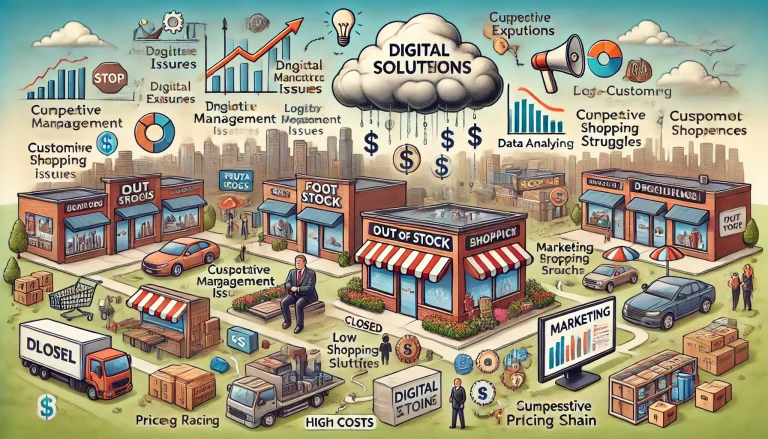Problem Statement
Inventory control specialists face significant challenges in managing stock levels efficiently. Issues such as overstocking, understocking, and supply chain disruptions can lead to financial losses and decreased customer satisfaction. These problems are exacerbated by the need to balance demand forecasting with real-time inventory tracking, which requires sophisticated systems and processes. Traditional methods of inventory management are often inadequate, resulting in errors and inefficiencies that impact the overall performance of retail businesses. The proposed platform aims to provide a comprehensive solution for inventory control, integrating advanced technologies to enhance accuracy, efficiency, and responsiveness in stock management.
Pain Points
- Overstocking: Excess inventory leading to increased storage costs and potential waste.
- Understocking: Insufficient inventory resulting in lost sales and customer dissatisfaction.
- Supply Chain Disruptions: Interruptions causing delays and inconsistencies in inventory levels.
- Demand Forecasting: Difficulty in predicting future demand accurately.
- Real-Time Tracking: Challenges in maintaining accurate, up-to-date inventory records.
- Manual Errors: Human errors in inventory counting and recording.
- Integration Issues: Problems integrating inventory systems with other business processes.
- Data Utilization: Ineffective use of data analytics for inventory optimization.
- Inventory Turnover: Managing the balance between high turnover rates and maintaining sufficient stock.
- Compliance: Adhering to regulatory requirements and industry standards.

Future Vision
Our vision is to develop a comprehensive platform that revolutionizes inventory management for retail businesses. This platform will leverage advanced technologies such as AI for demand forecasting, IoT for real-time tracking, and blockchain for supply chain transparency. It will provide tools for accurate stock level monitoring, predictive analytics, and automated replenishment, ensuring optimal inventory levels at all times. By integrating these technologies, the platform will enhance efficiency, reduce costs, and improve customer satisfaction. The goal is to create a seamless, end-to-end inventory management solution that addresses the complexities of modern retail operations and supports inventory control specialists in making informed, data-driven decisions.
Use Cases
- AI-Driven Demand Forecasting: Using machine learning algorithms to predict future inventory needs based on historical data and market trends.
- Real-Time Inventory Tracking: Implementing IoT devices to provide continuous, accurate updates on stock levels.
- Automated Replenishment: Setting up automated ordering systems to maintain optimal inventory levels.
- Supply Chain Transparency: Utilizing blockchain technology to track the movement of goods and ensure authenticity.
- Predictive Analytics: Analyzing data to identify patterns and make proactive inventory decisions.
- Inventory Auditing: Automating the audit process to reduce manual errors and ensure compliance.
- Integration with POS Systems: Seamlessly connecting inventory management with point-of-sale systems for accurate sales tracking.
- Warehouse Optimization: Enhancing warehouse operations through better layout planning and stock placement.
- Risk Management: Identifying and mitigating risks related to supply chain disruptions.
- Sustainability: Implementing practices to reduce waste and improve the environmental footprint of inventory management.
Target Users and Stakeholders
Target Users:
- User: Inventory control specialists, supply chain managers, and retail store managers
- Age Group: 25-55 years
- Gender: M/F
- Usage Pattern: Daily use for monitoring, managing, and optimizing inventory levels.
- Benefit: Improved efficiency, reduced costs, and enhanced customer satisfaction through accurate and proactive inventory management.
Stakeholders:
- Retailers: Businesses looking to optimize their inventory management processes.
- Suppliers: Partners involved in the supply chain seeking better coordination and transparency.
- Technology Providers: Companies offering AI, IoT, and blockchain solutions for inventory management.
- Logistics Providers: Entities responsible for the transportation and delivery of goods.
- Employees: Workers involved in inventory management and warehouse operations.
- Customers: End-users benefiting from improved product availability and reduced stockouts.
- Regulatory Bodies: Organizations ensuring compliance with industry standards and regulations.
Key Competition
- SAP: Offers comprehensive ERP solutions including advanced inventory management tools.
- Oracle NetSuite: Provides cloud-based inventory and order management solutions.
- Fishbowl: Specializes in manufacturing and warehouse inventory management software.
- TradeGecko (QuickBooks Commerce): Cloud-based inventory management platform for small and medium-sized businesses.
- Zoho Inventory: Offers inventory control and order management solutions for businesses of all sizes.
Products/Services
- SAP: ERP systems with integrated inventory management modules.
- Oracle NetSuite: Cloud ERP with real-time inventory tracking and demand planning.
- Fishbowl: Inventory management software tailored for manufacturers and warehouse operations.
- TradeGecko: Inventory and order management platform with robust analytics and automation features.
- Zoho Inventory: Comprehensive inventory control software with multi-channel selling capabilities.
Active Startups
- Locus Robotics: Develops autonomous robots for warehouse automation and inventory management.
- 6 River Systems: Provides collaborative mobile robots for warehouse fulfillment.
- Relex Solutions: Offers retail optimization software for demand forecasting and inventory planning.
- ShipBob: Provides e-commerce fulfillment solutions with real-time inventory tracking.
- Flexe: On-demand warehousing and inventory management platform.
- ClearMetal: Uses AI and machine learning to optimize supply chain visibility and inventory management.
- Verusen: AI-driven inventory optimization platform for supply chains.
- Waresix: Logistics platform offering real-time inventory and warehouse management.
- StockIQ: Supply chain planning and inventory optimization software.
- Inventory Planner: Demand planning and inventory optimization tool for e-commerce businesses.
Ongoing Work in Related Areas
- Development of AI algorithms for more accurate demand forecasting and inventory optimization.
- Innovations in IoT for enhanced real-time inventory tracking and monitoring.
- Research on blockchain applications for supply chain transparency and traceability.
- Advancements in warehouse automation technologies, including robotics and smart shelving.
- Studies on the economic and environmental impact of optimized inventory management practices.
Recent Investment
- Locus Robotics: $150 million Series E funding for expanding warehouse automation solutions (January 2024)
- 6 River Systems: Acquired by Shopify for $450 million to enhance fulfillment capabilities (March 2024)
- Relex Solutions: $100 million investment from TCV for global expansion and product development (February 2024)
- ShipBob: $68 million Series D funding for scaling fulfillment operations (April 2024)
- Flexe: $70 million Series C funding for expanding on-demand warehousing services (May 2024)
Market Maturity
The market for inventory management solutions is maturing rapidly, driven by the increasing complexity of supply chains and the demand for more efficient, data-driven processes. The integration of advanced technologies such as AI, IoT, and blockchain is transforming how businesses manage their inventory, providing greater accuracy, transparency, and responsiveness. Established players and innovative startups are both contributing to the evolution of this market, offering a range of solutions to meet the diverse needs of retail businesses. As technology continues to advance, the adoption of sophisticated inventory management systems is expected to become more widespread, leading to further improvements in efficiency and customer satisfaction.
Summary
Inventory control specialists face significant challenges in managing stock levels efficiently, including issues like overstocking, understocking, and supply chain disruptions. These problems are compounded by the need to balance demand forecasting with real-time inventory tracking, requiring sophisticated systems and processes. Our proposed platform aims to address these challenges by integrating advanced technologies such as AI for demand forecasting, IoT for real-time tracking, and blockchain for supply chain transparency. The platform will provide tools for accurate stock level monitoring, predictive analytics, and automated replenishment, ensuring optimal inventory levels at all times. By enhancing efficiency, reducing costs, and improving customer satisfaction, the platform will support inventory control specialists in making informed, data-driven decisions and transforming inventory management for retail businesses.



